Abstract
The recent surge of the Fourth Industrial Revolution has set forth demands for a new generation of the labor force with a comprehensive set of skills to meet the standards of the global market. Despite widespread concerns about educational reforms and renovations to enhance the workforce capacity in terms of information and communication technology (ICT) skills, research into the digital proficiencies of students has been limited in Vietnam. This dataset contains 1061 observations on the digital competency level of 10th-grade students in 20 surveyed schools from five provinces in Vietnam. The investigation, joining frequentist and Bayesian analyses, aims to provide valuable insights into the current state of children’s attitudes, behaviors, competency levels, and use of ICT within the Vietnamese educational context. The values of the dataset lie in its proposed scientific framework for replication in multiple regions and contexts as well as the feasibility of categorical regression techniques together with Bayesian statistics for hierarchical regression analysis.
Dataset: The dataset is submitted and will be published as a supplement to this paper.
Dataset License: CC-BY
1. Summary
This manuscript introduces a dataset (Supplementary Materials) of 1061 observations of students from 20 senior high schools across five provinces and cities in Vietnam. The dataset was collected as a component of the “Digital Kids Asia Pacific (DKAP)” project that aimed to investigate school students’ information and communication technology (ICT) competency levels in Asia-Pacific through four pilot countries: Vietnam, Bangladesh, Fiji, and the Republic of Korea. The DKAP investigation, implemented by the United Nations Educational, Scientific, and Cultural Organization (UNESCO) in Bangkok within the scope of the “Fostering Digital Citizenship through Safe and Responsible Use of ICT” Project, seeks to establish concrete understanding of ICT use and competency levels of regional children by creating and verifying a framework to gather quantitative data reflecting their attitudes, perceptions, proficiency, and behavioral use of ICT in an educational setting. The compiled data include information regarding respondents’ demographic and personal features such as gender, ICT awareness and access, socioeconomic status, school and neighborhood living standards, and their digital citizenship competencies.
The goal of this dataset is not only to describe students’ ICT cognitive and non-cognitive skills, but also to encompass a thorough examination of the relationship between demographic, cognitive, behavioral, sociocultural, and contextual factors, and the digital competencies of school students. Utilizing both the frequentist and Bayesian approaches, analyses of these data would shed light on possible predictive factors and the determinants of ICT proficiency as an essential ability of future global citizens.
This research is particularly crucial to developing economies that rely heavily on technology transfer to boost technological progress and sustain long-term economic growth [1] Research has confirmed the underlying significance of human capital stock in secondary and tertiary levels of education, as absorption capacity, in facilitating technology transfer [1,2]. The ICT skills readiness of school students is even more critical for low and middle-income economies in the era of Industry 4.0, which presents substantial challenges and opportunities. In Vietnam as a particular case study, researchers have pointed out the increased risks for the “middle-income trap” where investment will recede due to the rising labor cost and poor labor-saving technology [3]. As Vietnam transits from traditional entrepreneurship to a new ‘computational entrepreneurship [4,5], skill shortages are another problem facing the Southeast Asian country, with the highest percentage of wage workers at risk due to automation in the region [6]. As of 2016, low skilled workers still took up to over one-third of the total labor force in the country [7], despite a growing demand for information technology (IT) workers by 47% per year [8]. Alongside the possible disruption in growth rates and concerns over the weak human capital, Vietnam’s cybersecurity is still vulnerable, with a four-fold increase of the number of cyberattacks and incidents within one year from 2015 to 2016 [9]. Vietnam only ranked 101 out of 193 countries in a global cybersecurity index in 2017 [10]. Recognizing this peril of falling far behind in the age of digitalization, the Vietnamese government has made an effort to improve skills education for youth, especially technical education [11]. In addition to enhancing the competitiveness of the labor force, digital competencies are also relevant to widespread concerns facing the global community such as cyberbullying, youth suicide, depression, or behavioral disorders [12]. Therefore, findings from this dataset are expected to have significant implications for the development and evaluation of management and capacity-building policies in the emerging country.
Within the scope of this text, description of the dataset, including the survey questionnaire, potential research questions, the research framework, and our data collection procedure will be presented. Examples of possible statistical model methods and analyses will also be provided. Limitations and potential implications of the dataset will be discussed in the final section of the paper.
2. Data Description
DKAP was proposed as part of UNESCO’s “Enhancing National Capacity to Foster Digital Citizenship Education in Asia Pacific” project to understand students’ digital competency in the Asia Pacific region. The project was financially supported by the Government of the Republic of Korea Funds-In-Trust and Google in close cooperation with The International Telecommunication Union (ITU) and The United Nations Children’s Fund (UNICEF).
The DKAP survey tool has been assessed as reliable and validated to measure digital citizenship competencies under the DKAP Framework. A total of 5129 responses from children aged 15 from four countries—Bangladesh, Fiji, South Korea, and Vietnam—have been obtained using the instrument within the scope of a comparative investigation study of digital citizenship across the pilot countries.
The Vietnam Institute of Educational Sciences (VNIES) became the focal point of the Ministry of Education and Training to carry out the project component in Vietnam. VNIES signed the contract with UNESCO Hanoi (N0 4500363176) to conduct the survey in September 2018 in five provinces within the country. The survey questionnaire of the project in Vietnam was translated into Vietnamese from the English version of the DKAP framework.
The dataset contains responses by 1061 15-year-old school students regarding their digital competencies. The questionnaire consists of 117 multiple-choice questions, most of which require the respondents to choose one single answer out of the provided options, while some of the questions ask for more than one answer. Questions and answers were treated as discrete and continuous variables and encoded according to the coding instructions provided by UNESCO (see the dataset). The questions were divided into two groups: group (1), contextual questions; and group (2), digital competence questions. Group 1 contains 33 items asking for students’ ICT experiences along with their demographic information. Group 2 contains 84 items concerning students’ ICT competencies across five different domains.
2.1. Group (1) Personal Background Questions
The 33 question items in group (1) cover three domains: (1) student personal background (eight items); (2) access and usage of digital devices (18 items); and (3) socioeconomic status (SES) (seven items).
2.1.1. Domain (1): Student Personal Background
In domain (1), the first two questions are ‘Gender’ and ‘Year of birth’. The question of ‘Gender’ offers two options: ‘female’ and ‘male’ (‘F1’). Other questions within this domain ask about the surveyors’ current study grade level (‘F3’), the language they use (‘F4’), their country (‘F5’), expected highest level of education(‘F6’), number of days absent from school (‘F7’), and time spent on outside-school activities (‘F8’).
The distribution of answers for domain (1) questions is presented in Table 1. The percentage of female participants is slightly higher than male participants (by 6.2%). Nearly all (99%) of the students were born in 2003, and all were in Grade 10. In the Vietnamese 12-grade education system, these students were in the first year of senior high school.

Table 1.
Distribution of students according to their personal background.
The question of academic expectation asks about the highest expected education level. The responses were encoded as variable ‘F6’. Statistics show that the majority of students wished to complete post-secondary (36%) and masters/doctoral level (33.5%). Distributions of responses to F6 by gender can be found in Figure 1.
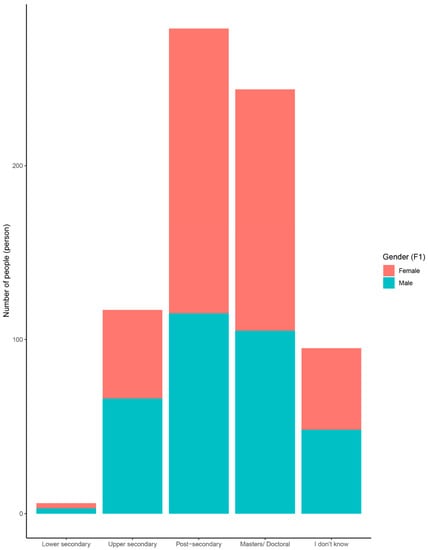
Figure 1.
Students’ highest expected level of education by gender.
2.1.2. Domain (2): Access and Usage of Digital Devices
Regarding students’ access and usage of digital devices, the first question in domain (2) on students’ “experience of using digital devices” yields four values: ‘never’, ‘less than 1 year’, ‘1–2 years’, ‘3–4 years’, and ‘more than 5 years’ (‘G1’). The other questions in this domain collect information about the frequency of students’ Internet access from a digital device (‘G2’); the location from which they are connected to the Internet (‘G3’), the types of digital devices used for Internet connection from home (‘G4’), school (‘G5’), or a local community access point (‘G6’); the type of Internet connection at home (‘G7’), school (‘G8’), or a local community access point (‘G10’); whether students can access the Internet at a public venue or not (‘G9’); people who provided instructions on computers and the Internet (‘G11’ and ‘G12’); the purpose and use of Internet connections (‘G13’–‘G16’); and experiences with coding and software development (‘G17’ and ‘G18’).
The distribution of answers for domain (2) questions is presented in Table 2. Almost all the students had Internet coverage at home (97.2%).

Table 2.
Distribution of students according to their access and usage of digital devices.
The responses to questions on the purposes of computer and Internet usage were encoded as continuous variables ‘G13’, ‘G14’, ‘G15’, and ‘G16’. Statistics indicate that the modal value for ‘G13’ is 1–2 h of computer and Internet usage per day for school study purposes.
Figure 2 depicts the distribution of values for variable ‘G14’ about the amount of time spent online or using computer by gender. The horizontal axis refers to the provided different time lengths. The blue columns represent the number of female students, and the red columns represent the number of male students. It can be seen that a large number of students spent between one and two hours online for personal study purposes (55%). It also seems that female students preferred spending more hours online or using a computer than their male counterparts.
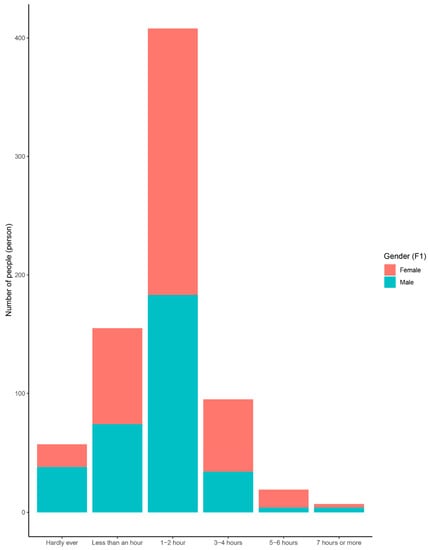
Figure 2.
Distributions of students by gender according to their time spent being on the Internet or using a computer.
2.1.3. Domain (3): Socioeconomic Status (SES)
Questions regarding socioeconomic status in domain (3) concerned issues such as the highest education level of students’ parents (‘H2’ and ‘H3’), level of access to physical (‘H4’) and academic resources (‘H5’), and level of support by others (‘H6’ and ‘H7’). The distribution of answers for domain (1) questions is presented in Table 3.

Table 3.
Distribution of students according to their socioeconomic status.
Regarding the level of help and support from others, less than a quarter of parents/caregivers were perceived as being highly concerned for their children’s cyber safety (‘H6_1’). The level of encouragement from parents, teachers, peers, and siblings for the students’ online learning activities also seem to be low (‘H7’).
2.2. Group (2) Competency Questions
The purpose of group (2) questions is to learn about competency level in using digital technology and the capacity to manage potential risks caused by digital technology. This group comprises five domains and corresponding component capacities: Digital Literacy, Digital Safety and Resilience, Digital Participation and Agency, Digital Emotional Intelligence, and Creativity and Innovation (see the dataset).
The Digital Literacy domain consists of 14 questions assessing the use of tools and digital information: for example, the ability to use software and digital devices and exploit digital information in different contexts. Assessing scale is in the form of a four-point Likert scale measuring the extent to which students can exploit tools and digital information. The visual distribution of responses for this variable is displayed in Figure 3a. The modal option is ‘agree a little’ to the ability to use digital tools and information, followed by an almost 30% proportion of the respondents claiming to ‘agree a lot’, meaning highly confident in their ability to handle digital tools and information. Besides, the distribution of gender in each choice is relatively homologous. The mean scores by gender in the Digital Literacy domain is around 3.1 (Figure 3b).
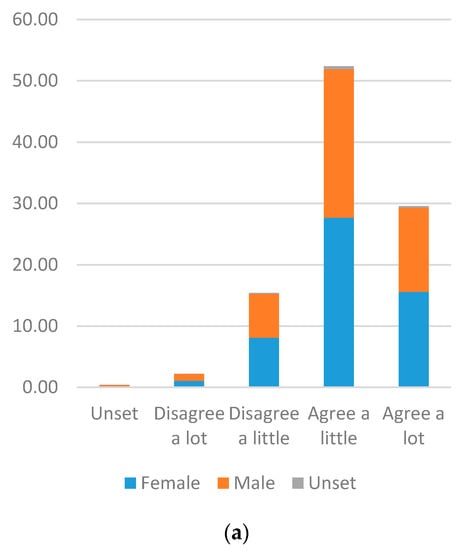
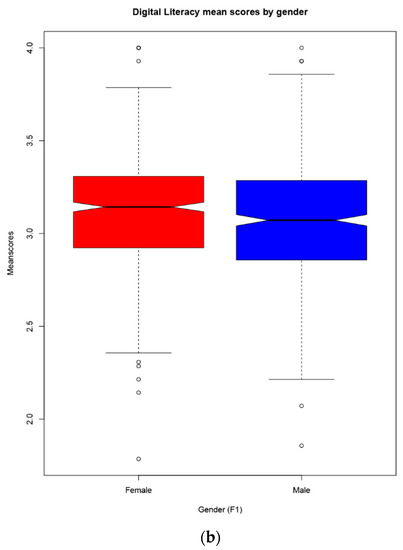
Figure 3.
(a) bar chart of students’ ability to use tools and digital info, and (b) box plot of mean scores by gender in the Digital Literacy domain.
Similarly, the other four domains (Digital Safety and Resilience, Digital Participation and Agency, Digital Emotional Intelligence, and Creativity and Innovation) also employ a four-point Likert scale to evaluate the corresponding capacities. Figure 4 illustrates the distributions of responses in each of the domains.
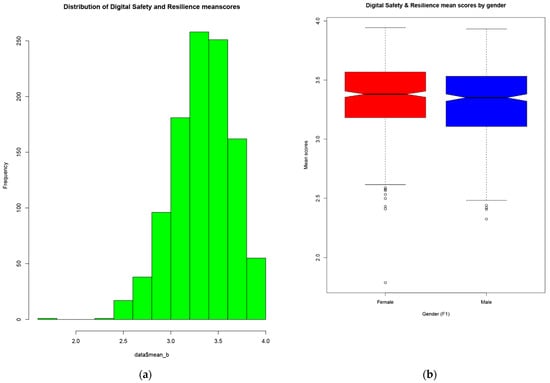
Figure 4.
(a) Histogram of mean scores and (b) Box plot of mean scores by gender in the Digital Safety and Resilience domain.
The Digital Safety and Resilience domain includes 18 questions examining students’ understanding about digital rights, privacy protection, well-being, and risk management ability in the digital world. Figure 4a is the histogram of mean scores, which suggests that most of the students felt that they understood their rights, and knew how to protect their privacy and react to potential risk in the digital world. Figure 4b shows a small discrepancy in responses between girls and boys in this domain.
Figure 5a presents the distribution of responses in the Digital Participation and Agency domain with 12 questions evaluating students’ reactions and behaviors regarding collaboration as well as engagement in the digital environment. The statistics show that most of the responses are in the range of “disagree a little” to “agree a little”. Figure 5b demonstrates that girls scored slightly higher than boys in this domain.
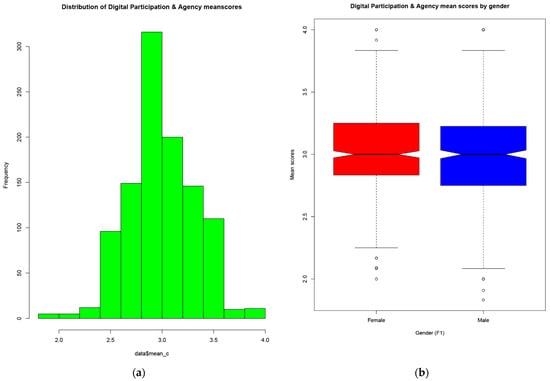
Figure 5.
(a) Histogram of mean scores and (b) Box plot of mean scores by gender in the Digital Participation and Agency domain.
The distribution of students’ answers to questions in the Digital Emotional Intelligence domain is displayed in Figure 6a. This domain consists of 16 questions aiming to assess students’ interpersonal skills and awareness when joining the digital world (i.e., their use of social networking sites and real-time chatting apps). The histogram of mean scores demonstrates that most of the answers fall into the range of “agree a little” to “agree a lot”, meaning that the students showed firm understanding and awareness of legitimate cyber behaviors. The mean score in this domain is not high (around three), with a narrow gap between answers by boys and girls (Figure 6b).
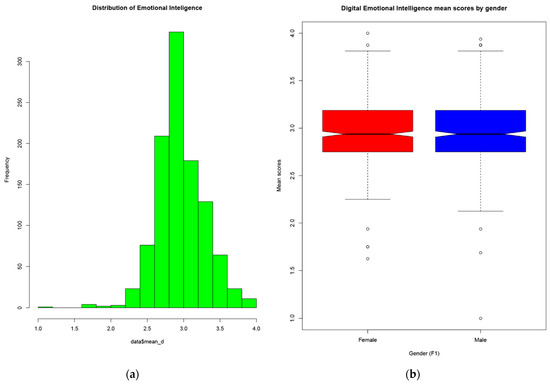
Figure 6.
(a) Histogram of mean scores and (b) Box plot of mean scores by gender in the Digital Emotional Intelligence domain.
The Creativity and Innovation domain contains 11 questions measuring students’ ability to develop creative digital products and present oneself in the digital world. Figure 7a suggests that most of the responses have the value of “disagree a little”. This means that the majority of surveyors were slightly doubtful of their originality and creativeness in manipulating digital resources on online platforms.
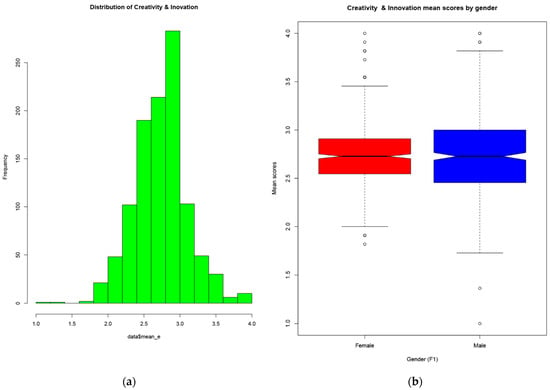
Figure 7.
(a) Histogram of mean scores and (b) Box plot of mean scores by gender in the Creativity and Innovation domain.
It is noted that questions 15 to 18 concerning digital resilience are in multiple-choice instead of Likert-scale form (see the dataset). The descriptive statistics of questions 15 to 18 are listed in Table 4.

Table 4.
Distribution of responses to questions 15 to 18 concerning digital resilience.
2.3. Potential Research Questions
Use of the Internet or digital devices at home is a vital factor influencing primary students’ ICT literacy [13]. Specifically, a study in German primary schools suggested a lack of parental concern for the online behaviors of their children from lower socioeconomic backgrounds [14]. Moreover, it is not easy to obtain the goal of digital equity among students from different backgrounds [15]. In general, a higher level of self-efficiency is associated with a better level of self-perceived digital competencies [16]. Regarding gender, there are differences in the basic digital competencies of male and female university students [17]. Drawing on the dataset, we present potential research questions in the following list.
- What are the background factors that could affect students’ digital competency levels?
- How do socioeconomic conditions affect students’ digital competency levels?
- What are the factors related to the access and usage of digital devices that could affect the digital competencies of students in any domains?
- Is there any relationship between high academic expectation and students’ digital competency levels?
- Is there any correlation among the five domains of digital competencies?
- Are there any differences in the digital competency levels of male and female school students?
3. Methods
3.1. Research Framework
This research is theoretically based on Bronfenbrenner’s bio-ecological model, which describes a child’s maturity in interactions with multiple levels of sociodemographic, cultural, and societal elements that constitute his or her community [18]. In particular, the model proposes four layers of the environment with a respective impact on a child’s cognitive growth.
As illustrated in Figure 8, the innermost circle represents a microsystem that contains the developing individual together with their personal and closest ties. The next layer is a mesosystem involving the interdependence of the microsystems with which the developing individual actively interacts (e.g., the child’s interrelationship between home and school environments). This is accommodated in an ecosystem with contexts having indirect and distant effects on the developing child. The outermost layer macrosystem encompasses systematic cross-cultural compatibilities together with philosophies or ideologies that reinforce the structure.
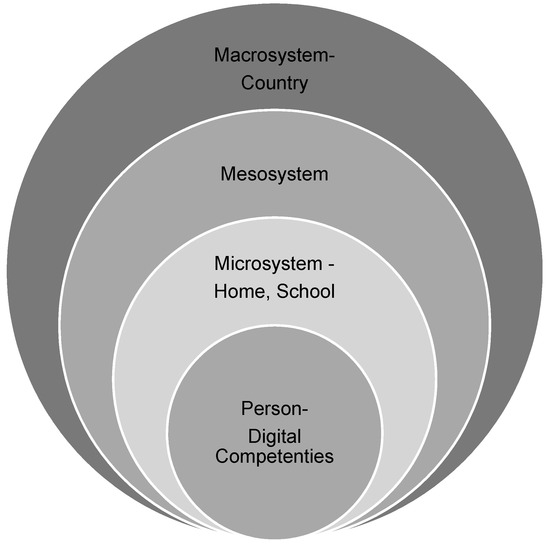
Figure 8.
Research framework of the study.
Given the scarcity and underdevelopment of theoretical explanations for children’s development of digital competencies, Bronfenbrenner’s bio-ecological model serves as a useful framework by offering a child-centered approach to examine children’s behaviors, knowledge, or attitudes relating to ICT, considering multiple layers of social impacts, and illustrated in the form of concentric circles of family, schools, or community and culture.
The framework employed in this study proposes three sets of interconnections:
- ○
- Personal level within the microsystem;
- ○
- Social mediation level, primarily concerning home, school system, and peer networks within the mesosystem; and
- ○
- National level where the country is the subject of analysis, and the macro levels of socioeconomic classification, systems of regulation, and cultural values act as influential factors.
The Conference on Digital Citizenship Education in Asia-Pacific and the subsequent experts’ meeting have proposed a detailed framework of digital citizenship domains, proficiencies, and performance indicators to comprise a wide parameter of essential competencies for a digital citizen to adapt to, develop, and serve the digital community in the 21st century. An itemized description of the framework is provided in Table A1, Appendix A. Definitions of the five suggested domains are listed in Table 5 below.

Table 5.
Digital citizenship domains and descriptions. ICT: information and communication technology.
The framework takes a rights-based and child-centered approach aligned with the commonly endorsed Convention on the Rights of the Child, which constitutes a common reference on human rights standards for children.
3.2. Data Collection
The research team strictly followed UNESCO’s procedure for the survey: (1) Organizing the consultancy workshop in July 2018 to review and develop the adapted version of the survey questionnaire; (2) Conducting the pilot test for the survey questionnaire at two schools in Hanoi and making necessary amendments in August 2018; (3) Contacting the target school administrators and coordinators and carrying out administrative work for the investigation; (4) Implementing the survey with the support of school coordinators in September 2018 at 20 schools across provinces in Vietnam; (5) Cleaning and encoding the data from 18 September to 1 October 2018, according to the codebook and coding instructions (see the dataset) provided by UNESCO Bangkok.
The sample geographical locations are indicated in the map in Figure 9. In total, the survey covered 1061 high school students (See Table A2, Appendix A) from 20 schools located in five provinces and cities: Lao Cai, Hanoi, Danang, Lam Dong, and Can Tho.
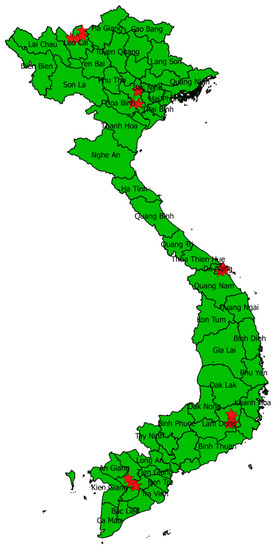
Figure 9.
The geographical locations of the five provinces and cities covered in the survey: Lao Cai, Hanoi, Danang, Lam Dong, and Can Tho.
3.3. Data Analysis
Raw data gathered from the questionnaire were entered into a spreadsheet at data.csv (see the dataset). Then, the data were processed and saved in CSV format for analyses using R statistical software (v3.5.3). Both frequentist and Bayesian statistics approaches were employed in the data analysis process.
3.3.1. Frequentist Analysis
Since the majority of variables in the dataset are categorical, most of the responses and predictor variables are discrete; thus, it’s appropriate to use logistic regression model for data analysis [19,20]. In the logistic regression model, we use the two following equations:
In which is the independent variable, and is the corresponding probability. Therefore, , with as the dependent variable.
The second equation estimates the probability of each item of dependent variables:
Besides, the data can be analyzed by a linear regression model for the numerical variables. The general equation of the linear equation is:
where is a continuous variable; and the independent variables can be concrete, categorical, or continuous.
The linear regression method is applied with the outcome variable being digital resilience (from ‘B15’ to ‘B18’), the father’s highest level of education (‘H2’), the student’s expectation of highest education level (‘F6’), and time spent using digital devices (‘G1’) as predictor variables. The regression coefficients are reported in Table 6.

Table 6.
Estimating of independent variables ‘father’s level of education’ and ‘student’s expectation of the highest education level’ against outcome variable ‘digital resilience’.
Examples of the code on R that were used to come up with the results in Table 6 are presented below:
| >t=file.choose() >data=read.csv(t, header=T, na.strings=“99”) >attach(data) > ds = lm(mean_b3 ~ factor(g1) + factor(f6) + factor(h2), data=data) > summary(ds) |
More examples of R code are provided in the dataset (see File CodeR.docx). The linear regression model is:
- Y = −0.182 − 0.034 × G1 (Less than 1 year) + 0.035 × G1 (1–2 years)
- + 0.046 × G1 (3–4 years) + 0.062 × G1 (More than 5 years) + 0.083 × F6 (Upper secondary)
- + 0.148 × F6 (Post-secondary) + 0.203 × F6 (Master/Doctoral) + 0.159 × F6 (I don’t know)
- + 0.019 × H2 (No education) − 0.008 × H2 (Primary) + 0.013 H2 (Lower secondary)
- −0.049 × H2 (Post-education) − 0.125 × H2 (Masters/Doctoral) − (−0.061) × H2 (I don’t know)
The following example in Table 7 presents the relationship between time spent using digital devices, biological sex, and the student’s digital emotional intelligence.

Table 7.
Estimating of independent variables ‘student’s time spent using digital devices’ and ‘student’s gender’ against outcome variable ‘digital emotional intelligence’.
3.3.2. Bayesian Analysis
The Bayesian statistics approach will also be used to examine the dataset in this section. A hierarchical regression model of the amount of experience that students have with using digital devices (‘G1’) according to their schools and sex was developed by employing R statistical software and BayesVL package (v0.7.5), which is available in [21]. Similar applications of Bayesian statistics can be found in [22,23]. The Bayesian approach is strong in visually demonstrating the results and the distributions of the coefficients. Moreover, the robustness of the model is tested by analysis of the sensitivity of the model to prior change. Its credibility is evident when the model does not show sensitivity to adjustment of the prior [24,25,26,27].
The mathematical formula of the model is as follows:
G1[i] = alpha[i,j] + beta_sex * sex[i]
In which j = 20 schools, and G1 is the student’s experiences in using digital devices: 1 = Never; 2 = Less than 1 year; 3 = 1–2 years; 4 = 3–4 years; and 5 = More than 5 years.
Examples of codes that were used to command the BayesVL package to construct the model are as follows:
# Design the model
model <- bayesvl()
model <- bvl_addNode(model, “G1”, “norm”)
model <- bvl_addNode(model, “sex”, “norm”)
model <- bvl_addNode(model, “schoolid”, “norm”)
model <- bvl_addArc(model, “schoolid”, “G1”, “varint”)
model <- bvl_addArc(model, “sex”, “G1”, “slope”)
# Generate the stan code for model
model_string <- bvl_model2Stan(model)
cat(model_string)
# Fit the model
fit <- bvl_modelFit(model, dkap_data, warmup = 2000, iter = 20000, chains = 4, cores = 1)
Moreover, the STAN codes that were generated by the BayesVL package for the model sampling and parameter learning are:
data {
// Define variables in data
// Number of level-1 observations (an integer)
int<lower=0> Nobs;
// Number of level-2 clusters
int<lower=0> Nschool;
// School IDs
int<lower=1, upper=Nschool> schoolid[Nobs];
int<lower=1> sex[Nobs];
// Continuous outcome
real g1[Nobs];
}
parameters {
// Define parameters to estimate
// Level-1 errors
real<lower=0,upper=100> sigma_e0;
// Varying intercepts
real alpha_school[Nschool]; // intercept estimated with 20 schools
real mu_alpha; // mean for intercepts
real<lower=0,upper=100> sigma_alpha;
// Population slope
real beta_sex;
}
transformed parameters {
// Individual mean
real mu[Nobs];
// Individual mean
for (i in 1:Nobs) {
mu[i] = alpha_school[schoolid[i]] + sex[i] * beta_sex;
}
}
model {
// Prior part of Bayesian inference
// Flat prior for mu (no need to specify if non-informative)
// Random effects distribution
alpha_school ~ normal(mu_alpha, sigma_alpha);
// Likelihood part of Bayesian inference
// Outcome model N(mu, sigma^2) (use SD rather than Var)
g1 ~ normal(mu, sigma_e0);
}
The results from the hierarchical regression model are as in Table 8.

Table 8.
Results of hierarchical regression model.
The posterior coefficients are shown in Figure 10:
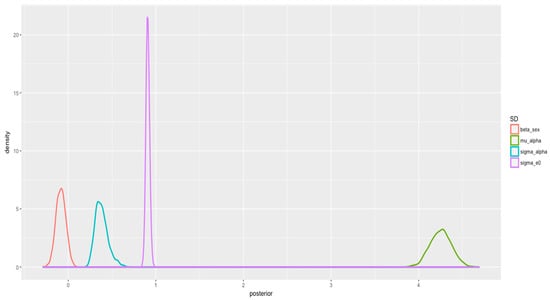
Figure 10.
All posterior coefficients.
The posterior distribution of all the coefficients is as in Figure 11. The mean of the mu_alpha is around 4.2, which shows a high level of usage of technological devices.
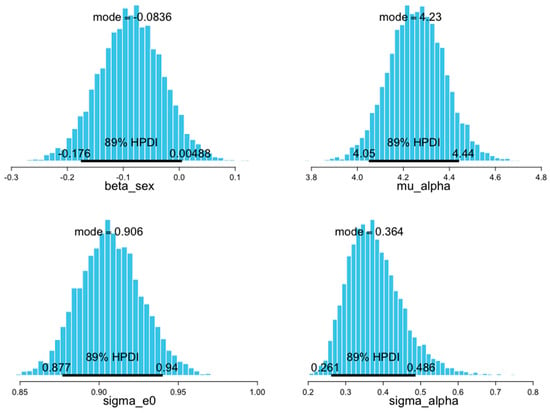
Figure 11.
The posterior distributions of all the coefficients. Note: HPDI: highest posterior density interval.
In the model, the correlation coefficients’ posterior distributions are presented in Figure 12. The diagonal boxes present the posterior distributions for individual coefficients: beta_sex, sigma_e0, mu_alpha, and sigma_alpha. The simulated pairs of each coefficient are shown in the off-diagonal boxes. All satisfy the standard distributions.
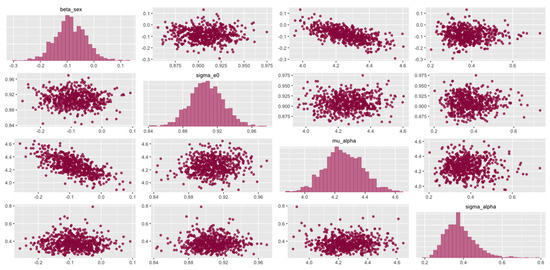
Figure 12.
The correlation of coefficients’ posterior distribution.
The log posterior of the model is shown in Figure 13:
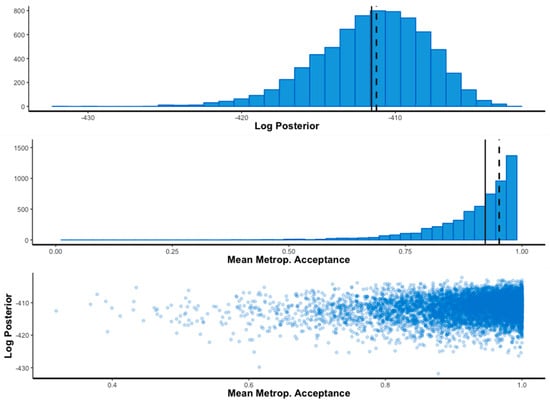
Figure 13.
The log posterior of the model.
Figure 14 shows the comparison among surveyed schools in the digital device usage experience of students. The overall usage of the digital device is above average, and it is notable that many schools from more developed cities such as Hanoi or Danang show a low level of digital device usage.
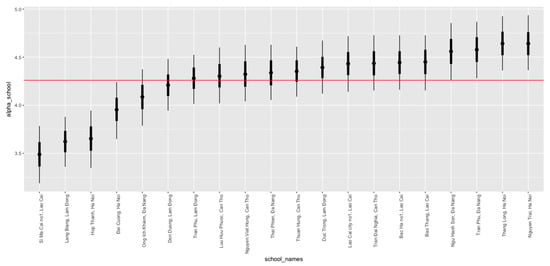
Figure 14.
Comparison among surveyed schools in the digital device usage experience of students.
Figure 15 explains the correlation between sex and the usage of technological devices based on the slope coefficient beta_sex. The sex and usage of digital devices show low correlation, but female students demonstrate a slightly higher level of usage than their male counterparts because the value of the coefficient is smaller than zero.
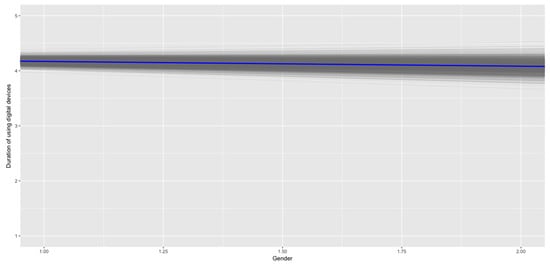
Figure 15.
The correlation between sex and usage of technological device.
4. Conclusions and User Notes
Our dataset offers comprehensive descriptive statistics yielding significant insights regarding digital citizenship competencies in the Vietnamese educational context, specifically school students’ perceptions, proficiency levels, and behavioral use of ICT. This research area has rarely been studied in the field of Social Sciences and Humanities, despite potential challenges concerning professional development facing developing countries such as Vietnam in the age of Industry 4.0. With over 100 question items collecting information across the five domains—Digital Literacy, Digital Safety and Resilience, Digital Emotional Intelligence, Creativity and Innovation, and Digital Participation and Agency—the dataset contains values of multiple variables, both categorical and continuous, hence allowing potential diverse methodologies of in-depth analyses and the strict control of variables.
The richness of our dataset would foster further research on multifaceted domains of digital competencies in adolescents. Promising grounds for future investigations include the effects of school-related factors such as curriculum, teaching practices, syllabi or assessment criteria and format, as well as non-educational factors concerning demographic backgrounds, daily time-spending routines, or online behavioral activities. Research into these areas is critical, as ICT skills have been identified as one of the major barriers to students and teachers’ readiness for STEM (Sciences, Technology, Engineering, and Mathematics) education [28]. Scientific findings regarding the determinants of both the cognitive and the non-cognitive attributes of the ICT competency of students would comprehensively inform future decisions and suggestions for policy development, particularly in the education sector in developing countries with similar socioeconomic structures to Vietnam [29].
In addition to presenting the dataset, this article also explores statistical methods for data analysis, which is categorical data in this dataset. Traditionally, the frequentist approach is used for data analysis. However, as the scientific community is debating over the traditional approach, due to the manipulation of statistical significance and other misconducts such as stargazing, p-hacking, or HARKing [30], we also introduce the application of Bayesian statistics for hierarchical regression analysis. The employment of both frequentist and Bayesian approaches are expected to strengthen the credibility and soundness of scientific results produced from the dataset, which would pique the interests of the scientific community and policymakers.
The values of this dataset are beyond the instant analyses of data, considering its high replicability of methodology and the survey framework in different regions and contexts. As stated earlier in this text, the study was originally designed to make a cross-national comparison of data in four countries: Bangladesh, South Korea, Vietnam, and Fiji. The findings derived from this dataset would be more generalizable if the target sample is extended to include more observations from students at different levels of study rather than limited to only 10th graders. A more comprehensive sample, which is entirely feasible in the future, would allow interesting cross-regional and cross-generational findings on a panoramic scale.
Therefore, replicating the survey framework to yield comparable datasets would contribute to a cross-boundary database with immense scientific implications. Knowledge sharing, open access to data and information are also aligned with the current movements in the academic world that resulted from better communication and connection concerning international collaboration in research, transparency of data processing, and Open Science [31,32]. It is not unusual nowadays that studies with groundbreaking findings are attained by large research groups from all over the world, such as the picture of the black hole [33] or the large dataset of societies [34]. All these changes will ultimately address the global sustainable development goals of United Nations. This is also the original aim of this investigation by UNESCO, and the reason why the organization approved the dissemination and access of this dataset.
Supplementary Materials
The following are available online at https://www.mdpi.com/2306-5729/4/2/69/s1, Figure S1: title, Table S1: title, Video S1: title.
Author Contributions
Conceptualization, A.-V.L. and Q.-H.V.; methodology, Q.-H.V., V.-P.L., D.-L.D.; software, Q.-H.V., V.-P.L.; validation, T.-H.D., H.-N.N., D.-L.D., and V.-P.L.; formal analysis, T.-H.D., D.-L.D., and V.-P.L.; investigation, D.-L.D., H.-N.N., and H.-K.T.N; resources, A.-V.L., D.-Q.P., and D.-L.D.; data curation, D.-Q.P., H.-N.N., and T.-H.D.; writing—original draft preparation, P.-H.H., D.-L.D., H.-N.N., T.-T.V., H.-K.T.N., and M.-T.H.; writing—review and editing, M.-T.H., P.-H.H., T.-T.V., H.-K.T.N.; visualization, D.-L.D., V.-P.L.; supervision, A.-V.L., Q.-H.V.; project administration, D.-Q.P., A.-V.L., M.-T.H., and Q.-H.V.
Funding
This research was funded by UNESCO under the contract N0 4500363176.
Acknowledgments
The authors would like to send appreciation to members of UNESCO: Jian Xi Teng and Jonghwi Park (UNESCO Bangkok) and Toshiyuki Matsumoto and Hoang Diem Huyen (UNESCO Hanoi) for their cooperation in implementing the Digital Kids Asia Pacific project. In addition, we would also want to express our gratitude to members of the survey team from the Vietnam National Institute of Educational Sciences, Hanoi—Nguyen Thu Huyen, Bui Dieu Quynh, Phan Thanh Ha, and Vuong Quoc Anh—for their tremendous efforts.
Conflicts of Interest
The authors declare no conflict of interest.
Appendix A

Table A1.
Digital Citizenship Framework.
Table A1.
Digital Citizenship Framework.
| DOMAINS | COMPETENCIES | SAMPLE PERFORMANCE INDICATORS |
|---|---|---|
| Digital Literacy | 1.1 ICT Literacy: Managing and operating ICT hardware and software responsibly in digital environments to access and search for data, information, and content, and to utilize them | 1.1.1 The child is able to copy and move a file or folder. 1.1.2 The child is able to copy and paste tools to duplicate or move information within a document. 1.1.3 The child is able to send e-mails with attached files (e.g., document, picture, video). 1.1.4 The child is able to use arithmetic formulae in a spreadsheet. 1.1.5 The child is able to connect and install new devices (e.g., a modem, camera, printer). 1.1.6 The child is able to find, download, install, and configure software. 1.1.7 The child is able to create electronic presentations with presentation software (including text, images, sound, video, or charts). 1.1.8 The child is able to transfer files between a computer and other devices. 1.1.9 The child is able to write a computer program using a specialized programming language. 1.1.10 The child is able to use a search engine and advanced applications (e.g., digital financial services, online shopping, e-governance, online learning). 1.1.11 The child is open to learning new digital technology. 1.1.12 The child uses social media platforms to share ideas, participate in discussions, and collaborate with others. 1.1.13 The child is able to use mobile devices and applications with confidence. |
| 1.2 Information Literacy: The ability to seek, critically evaluate, and use digital information effectively to make informed decisions. | 1.2.1 The child has knowledge of the different information categories (e.g., PR, Advertising, Propaganda, Entertainment, Educational) and their motivations, goals, and outputs. 1.2.2 The child has knowledge of disinformation and unethical platforms e.g., clones, bots, fishing sites. 1.2.3 The child is able to contextualize and analyze information by a diverse range of categories (e.g., by location, culture, values, age, and ownership). 1.2.4 The child is able to analyze digital profiles of individuals and institutions. 1.2.5 The child is able to identify and evaluate information for credibility and reliability. 1.2.6 The child is able to make an informed judgment or decision based on information classification and local context (e.g., age, location, applicable laws) 1.2.7 The child is motivated to disseminate credible and reliable information. | |
| Digital Safety & Resilience | 2.1 Understanding Child Rights: Knowledge of legal rights and obligations within the global and local context | 2.1.1 RIGHTS (GLOBAL /LOCAL): The child demonstrates a comprehensive understanding of their legal rights under the Convention on the Rights of the Child and in applicable local laws (particularly rights to protection from all kinds of online violence, to access to information and education, to play and recreation, to freedom of thought, expression, and to participation). 2.1.2 OBLIGATIONS (GLOBAL /LOCAL): The child demonstrates a comprehensive understanding of their obligations under the Convention on the Rights of the Child and in applicable local laws to respect the rights of others (particularly the responsibilities to respect the rights, freedoms, and reputations of others, and not to breach applicable criminal, civil, or administrative laws online). |
| 2.2 Personal data, privacy and reputation: To understand how to use and share personally identifiable information while being able to protect oneself and others from harm. Be able to implement strategies for information and device security and personal security protocols | 2.2.1 DATA (YOURS): The child can apply principles of managing their personal data to maintain digital privacy and security and is able to take preventive measures against digital data collection. 2.2.2 PRIVACY (YOURS/OTHERS): The child understands the implications of sharing personal identifying information, photos, videos, comments, and opinions in different online contexts, and is able to engage in safe, legal, and ethical behavior that respects their own privacy as well as the privacy of others. 2.2.3 REPUTATION (YOURS/OTHERS): The child is able to cultivate and manage their digital identity and reputation and is aware of the permanence of their actions in the digital world. 2.2.4 INTELLECTUAL PROPERTY: The child understands and respects the rights and obligations of using and sharing intellectual property. | |
| 2.3 Promoting and Protecting Health and Well-Being: Ability to identify and manage health risks, and use digital technology in order to protect and improve the physical and psychological well-being of oneself and others | 2.3.1 BULLYING HARASSMENT and HATE SPEECH: Understand, identify, and successfully manage risks related to being a victim, perpetrator, or witness of bullying, harassment, or hate speech. 2.3.2 UNPLUG and ADDICTION: The child is able to manage their own use of technology, taking full advantage of technology while avoiding excessive time online and addiction. 2.3.3 PROTECTION (SEXUAL VIOLENCE): The child understands and is able to identify and successfully manage risks related to being a victim, perpetrator, or witness of sexual harassment, sexual extortion, grooming, and exposure to disturbing sexually violent or inappropriately graphic content. 2.3.4 IMPROVEMENT (PHYSICAL/PSYCHOLOGICAL): The child understands, accesses, and uses information to improve mental, physical, psychological, and sexual health online. | |
| 2.4 Digital Resilience: A set of preventative, reactive and transformative competencies that allow young people to avoid or cope with risky situations they face and improve themselves. | 2.4.1 AWARENESS: The child understands the potential risks in the digital environment. 2.4.2 INSTRUMENTAL ACTIONS: The child can prevent and respond to risk using digital skills and media literacy. 2.4.3 COGNITIVE ACTIONS: The child safely and critically engages with online content, adopts problem-solving and decision-making skills when facing online risks, and transforms challenging experiences into positive lessons. 2.4.4 COMMUNICATING: The child is willing to communicate with people when faced with a risky, upsetting, or potentially dangerous situation online. | |
| Digital Participation & Agency | 3.1 Interacting, Sharing, and Collaborating: The ability to interact, share data and information, and collaborate with others using suitable digital technologies to achieve shared goals (work, social, leveraging network, education, entertainment, etc.). | 3.1.1 The child is able to use digital tools to interact and share information and data with peers and other children from a variety of background and cultures. 3.1.2 The child is able to use digital tools to interact and share information and data with adults from a variety of background and cultures. 3.1.3 The child is able to use digital tools to work together with peers and other children to achieve a common goal. 3.1.4 The child is able to use digital tools to work together with adults to achieve a common goal. |
| 3.2 Civic Engagement: The ability and willingness to recognize, seek, and act on opportunities to positively influence local and global communities online and/or offline through appropriate digital technologies. | 3.2.1 The child is able to use ICT to discuss political and social issues with other people online 3.2.2 The child is able to use ICT to be involved in activities, associations, and movements on social and political issues. 3.2.3 The child is able to use ICT with the intention to influence society, locally or globally. 3.2.4 The child believes that their involvement contributed to a better world. | |
| 3.3 Netiquette: Demonstrate ethical and courteous behavior to inform choices in interacting and engaging in different digital environments with different audiences. | 3.3.1 The child acts with courtesy in their interaction with others while using digital tools. 3.3.2 The child demonstrates respect for others’ rights through their online behavior. 3.3.3 The child demonstrates non-discriminatory behavior that is also gender and culturally sensitive. | |
| Digital Emotional Intelligence | 4.1 Self-Awareness: Ability to explain one’s moods, emotions, drives, and how these affect oneself and others in the digital world through introspection. | 4.1.1 The child is able to explain emotions they have in any given time as a result of digital experiences. 4.1.2 The child is able to reflect on the relationship between emotions, action, and consequences as they engage in digital activities. 4.1.3 The child is able to assess his or her own strengths and weaknesses in managing one’s emotions when using digital technologies. |
| 4.2 Self-Regulation: Ability to manage one’s emotions, moods, and impulses during online engagements | 4.2.1 The child sets personal limits on the use of digital devices. 4.2.2 The child is able to control one’s emotions in the online environment. | |
| 4.3 Self-Motivation: Demonstrates initiative, commitment to attain internal or external goals despite setbacks in the digital sphere. | 4.3.1 The child sets goals to improve the self through digital opportunities. 4.3.2 The child acts on the set goals even in the face of challenges. 4.3.3 The child revises set goals based on digital experiences. | |
| 4.4 Interpersonal Skills: Build positive online relationships to communicate, build rapport and trust, embrace diversities, manage conflicts, and make sound decisions. | 4.4.1 The child can communicate with others with due courtesy, respect, and regard for one’s and others’ welfare through varied digital forms and contexts (e.g., words, symbols, or images). 4.4.2 The child demonstrates tact and diplomacy during online disagreements, differences of opinions, and the ability to diffuse difficult situations. 4.4.3 The child builds rapport and nurtures positive relationships through online engagements. 4.4.4 The child demonstrates respect and value for the dignity and worth of others through online interactions. | |
| 4.5 Empathy: Demonstrate awareness and compassion for the feelings, needs, and concerns of others during digital interactions | 4.5.1 The child displays sensitivity and takes emotional cues to respond to the needs, feelings, and perspectives of others when online. 4.5.2 The child takes appropriate actions to help those facing challenging circumstances or threats to their digital rights. | |
| Digital Creativity & Innovation: | 5.1 Creative Literacy: Apply skills and use tools to create/adapt and/or curate digital content | 5.1.1 The child applies a wide range of digital media tools to manipulate, create, or remix digital content (including photos, videos, music, text, etc.). 5.1.2 The child is capable of coding and developing applications. 5.1.3 The child is able to express ideas through the curation of existing digital material. |
| 5.2 Expression: The ability to use technology to represent or express creatively children’s identities. | 5.6.1 The child is able to utilize digital platforms to explore, experiment, and generate ideas. 5.6.2 The child is able to use digital platforms to creatively represent digital and real-life identities. 5.6.3 The child is able to use creative digital formats to express ideas and connect with others. |

Table A2.
List of all surveyed schools.
Table A2.
List of all surveyed schools.
| No | School Name | City/Province | School ID | Area |
|---|---|---|---|---|
| 1 | Đại Cường | Hanoi | V01 | rural |
| 2 | Hợp Thanh | Hanoi | V02 | rural |
| 3 | Thăng Long | Hanoi | V03 | urban |
| 4 | Nguyễn Trãi | Hanoi | V04 | urban |
| 5 | Lào Cai city no1 | Lao Cai | V05 | urban |
| 6 | Bảo Thắng | Lao Cai | V06 | urban |
| 7 | Bắc Hà no1 | Lao Cai | V07 | rural |
| 8 | Si Ma Cai no1 | Lao Cai | V08 | rural |
| 9 | Ông Ích Khiêm | Danang | V09 | rural |
| 10 | Trần Phú | Danang | V10 | urban |
| 11 | Ngũ Hành Sơn | Danang | V11 | rural |
| 12 | Thái Phiên | Danang | V12 | urban |
| 13 | Trần Phú | Lam Dong | V13 | urban |
| 14 | Don Duong | Lam Dong | V14 | rural |
| 15 | Duc Trong | Lam Dong | V15 | urban |
| 16 | Lang Biang | Lam Dong | V16 | rural |
| 17 | Trần Đại Nghĩa | Can Tho | V17 | rural |
| 18 | Nguyễn Việt Hồng | Can Tho | V18 | urban |
| 19 | Lưu Hưu Phước | Can Tho | V19 | urban |
| 20 | Thuận Hưng | Can Tho | V20 | rural |
References
- Lee, J.-W. Education for Technology Readiness: Prospects for Developing Countries. J. Hum. Dev. 2001, 2, 115–151. [Google Scholar] [CrossRef]
- Mutula, S.M.; Van Brakel, P. ICT skills readiness for the emerging global digital economy among small businesses in developing countries: Case study of Botswana. Library Hi Tech 2007, 25, 231–245. [Google Scholar] [CrossRef]
- Cameron, A.; Pham, T.; Atherton, J. Vietnam Today—First Report of the Vietnam’s Future Digital Economy Project; CSIRO: Brisbane, Australia, 2018. [Google Scholar]
- Vuong, Q.H. Computational entrepreneurship: From economic complexities to interdisciplinary research. Prob. Perspect. Manage. 2019, 17, 117–129. [Google Scholar] [CrossRef][Green Version]
- Vuong, Q.H.; Tran, T.D. The cultural dimensions of the Vietnamese private entrepreneurship. IUP J. Entrepreneurship Dev. 2009, VI, 54–78. [Google Scholar] [CrossRef]
- Chang, J.-H.; Rynhart, G.; Huynh, P. ASEAN in Transformation: How Technology is Changing Jobs and Enterprises; International Labour Office: Geneva, Switzerland, 2016. [Google Scholar]
- GSO. Annual Employed Population at 15 Years of Age and Above by Occupation and Year; General Statistics Office: Hanoi, Vietnam, 2016.
- VNA. Vietnam Lacks High-Quality IT Workforce. 2016. Available online: https://english.vietnamnet.vn/fms/science-it/166260/vietnam-lacks-high-quality-it-workforce.html (accessed on 8 May 2019).
- Oxford Business Group. The Report—Vietnam 2017; Oxford Business Group: Dubai, United Arab Emirates, 2017. [Google Scholar]
- ITU. Global Cybersecurity Index 2017; International Telecommunication Union (ITU): Geneva, Switzerland, 2017. [Google Scholar]
- UNESCO. Viet Nam Takes Action Towards STEM Education for Sustainable Development. 2017. Available online: http://un.org.vn/en/unesco-agencypresscenter1-100/4388-viet-nam-takes-action-towards-stem-education-for-sustainable-development.html (accessed on 8 May 2019).
- Illing, S. Bored and Lonely? Blame Your Phone. 2019. Available online: https://www.vox.com/recode/2019/5/2/18510958/social-media-addiction-boredom-loneliness-society-technology-smart-phones (accessed on 8 May 2019).
- Aesaert, K.; Van Nijlen, D.; Vanderlinde, R.; Tondeur, J.; Devlieger, I.; van Braak, J. The contribution of pupil, classroom and school level characteristics to primary school pupils’ ICT competences: A performance-based approach. Comput. Educ. 2015, 87, 55–69. [Google Scholar] [CrossRef]
- Heinz, J. Digital skills and the influence of students’ socio-economic background. An exploratory study in German elementary schools. Italian J. Sociol. Educ. 2016, 8, 186–212. [Google Scholar] [CrossRef]
- Tondeur, J.; Sinnaeve, I.; van Houtte, M.; van Braak, J. ICT as cultural capital: The relationship between socioeconomic status and the computer-use profile of young people. New Med. Soc. 2011, 13, 151–168. [Google Scholar] [CrossRef]
- Popa, D.; Topală, I.R. Students’ Digital Competencies, Related Attitudes and Self Directed Learning. In Proceedings of the International Scientific Conference eLearning and Software for Education, Bucharest, Romania, 19–20 April 2018; pp. 90–95. [Google Scholar]
- Vázquez-Cano, E.; Meneses, E.L.; García-Garzón, E. Differences in basic digital competences between male and female university students of Social Sciences in Spain. Int. J. Educ. Technol. High. Edu. 2017, 14, 27. [Google Scholar] [CrossRef]
- Bronfenbrenner, U.; Ceci, S.J. Nature-nuture reconceptualized in developmental perspective: A bioecological model. Psychol. Rev. 1994, 101, 568–586. [Google Scholar] [CrossRef] [PubMed]
- Fienberg, S.E.; Junker, B.W. Categorical Data Analysis. In International Encyclopedia of Education, 3rd ed.; Peterson, P., Baker, E., McGaw, B., Eds.; Elsevier: Oxford, UK, 2010; pp. 58–65. [Google Scholar]
- Agresti, A. Categorical Data Analysis, 3rd ed.; Wiley: Hoboken, NJ, USA, 2013. [Google Scholar]
- Vuong, Q.H.; La, V.-P. BayesVL Package for Bayesian Statistical Analyses in R. Github: BayesVL Package Version 0.6. 2019. Available online: https://github.com/sshpa/bayesvl (accessed on 20 April 2019).
- Vuong, Q.-H.; Bui, Q.-K.; La, V.-P.; Vuong, T.-T.; Nguyen, V.-H.T.; Ho, M.-T.; Nguyen, H.-K.T.; Ho, M.-T. Cultural additivity: Behavioural insights from the interaction of Confucianism, Buddhism and Taoism in folktales. Palgrave Commun. 2018, 4, 143. [Google Scholar] [CrossRef]
- Vuong, Q.-H.; Bui, Q.-K.; La, V.-P.; Vuong, T.-T.; Ho, M.-T.; Nguyen, H.-K.T.; Nguyen, H.-N.; Nghiem, K.-C.P.; Ho, M.-T. Cultural evolution in Vietnam’s early 20th century: A Bayesian networks analysis of Franco-Chinese house designs. arXiv 2019, arXiv:1903.00817v1. [Google Scholar] [CrossRef]
- Scutari, M.; Denis, J.-B. Bayesian Networks: With Examples in R; Chapman and Hall/CRC: London, UK, 2014. [Google Scholar]
- Kruschke, J. Doing Bayesian Data Analysis: A Tutorial with R, JAGS, and Stan, 2nd ed.; Academic Press: London, UK, 2014. [Google Scholar]
- Lynch, S.M. Introduction to Applied Bayesian Statistics and Estimation for Social Scientists; Springer: New York, NY, USA, 2007. [Google Scholar]
- McElreath, R. Statistical Rethinking: A Bayesian Course with Examples in R and Stan; Chapman and Hall/CRC: London, UK, 2018. [Google Scholar]
- Ejiwale, J.A. Barriers to successful implementation of STEM education. J. Educ. Learn. 2013, 7, 63–74. [Google Scholar] [CrossRef]
- Vuong, Q.-H. The (ir)rational consideration of the cost of science in transition economies. Nat. Hum. Behav. 2018, 2, 5. [Google Scholar] [CrossRef] [PubMed]
- Vuong, Q.H.; Ho, M.T.; La, V.-P. ‘Stargazing’ and p-hacking behaviours in social sciences: Some insights from a developing country. Eur. Sci. Edit. 2019, 45, 54–55. [Google Scholar]
- Vuong, Q.H. Open Data, Open Review and Open Dialogue in Making Social Sciences Plausible. 2017. Available online: http://blogs.nature.com/scientificdata/2017/12/12/authors-corner-open-data-open-review-and-open-dialogue-in-making-social-sciences-plausible/ (accessed on 8 May 2019).
- Wilkinson, M.D.; Dumontier, M.; Aalbersberg, I.J.; Appleton, G.; Axton, M.; Baak, A.; Blomberg, N.; Boiten, J.-W.; da Silva Santos, L.B.; Bourne, P.E.; et al. The FAIR Guiding Principles for scientific data management and stewardship. Sci. Data 2016, 3, 160018. [Google Scholar] [CrossRef] [PubMed]
- Collaboration, E.H.T. First M87 Event Horizon Telescope results. I. The shadow of the supermassive black hole. Astrophys. J. Lett. 2019, 875, L1. [Google Scholar] [CrossRef]
- Whitehouse, H.; François, P.; Savage, P.E.; Currie, T.E.; Feeney, K.C.; Cioni, E.; Purcell, R.; Ross, R.M.; Larson, J.; Baines, J.; et al. Complex societies precede moralizing gods throughout world history. Nature 2019, 568, 226–229. [Google Scholar] [CrossRef] [PubMed]
© 2019 by the authors. Licensee MDPI, Basel, Switzerland. This article is an open access article distributed under the terms and conditions of the Creative Commons Attribution (CC BY) license (http://creativecommons.org/licenses/by/4.0/).